The Franco-German Youth Office (FGYO)
Sous-titre
Interview with Anne Tallineau, French general secretary, and Tobias Bütow, German general secretary, FGYO
Anne Tallineau and Tobias Bütow are, respectively, the French general secretary and German general secretary of the Franco-German Youth Office (FGYO). Since 1963, the FGYO has had the goal of fostering relations between the young people of the two countries, aimed at improving mutual understanding. This takes the form of projects and exchanges linked to languages, culture or ecology. Since its founding, the FGYO has also been involved in remembrance, aimed at strengthening Franco-German friendship.
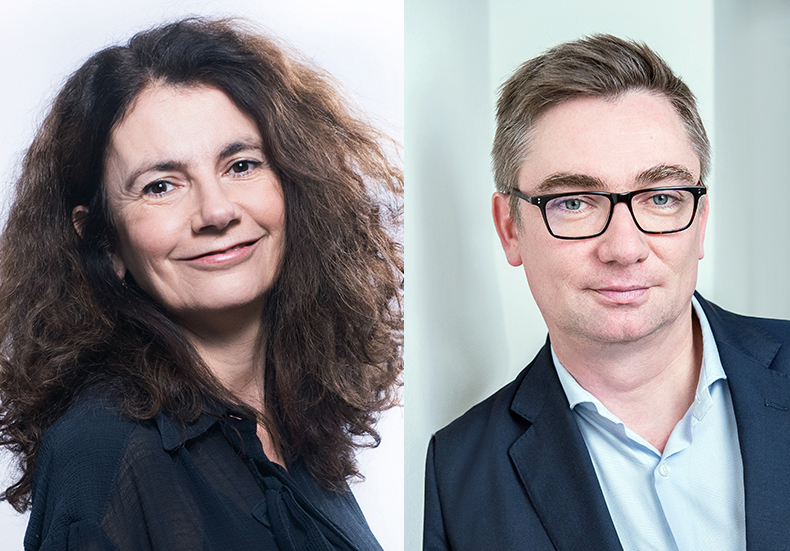
Left: Anne Tallineau © Olivier Vigerie Right: Tobias Büttow © Jennifer Sanchez - vonZynski
Can you give us some background to the birth of the FGYO?
The Franco-German Youth Office was born against the backdrop of the Élysée Treaty in 1963. The French president, Charles de Gaulle, and the German federal chancellor, Konrad Adenauer, forged Franco-German friendship with an unprecedented treaty in a Europe still weakened by the Second World War. The ambition of a united Europe was still in its early stages, and the cooperation between France and Germany played an important role in integrating Europe and overcoming former resentments. The creation of a Franco-German Youth Office was one of the cornerstones of reconciliation and remembrance. For nearly 60 years, it has served Franco-German cooperation, giving 9.3 million young people the opportunity to take part in over 380 000 projects.
Is the FGYO’s role still the same today as it was when it was founded?
Since its founding, the FGYO’s aim has been to bring young people from France and Germany together, through intercultural exchanges and the discovery of each other’s language and culture. But over nearly 60 years, the FGYO has successfully adapted to changes in society and the European project, as well as to the needs of young people. When it was founded, the exchanges were primarily extracurricular, group exchanges, but since then opportunities for professional development and access to young people outside France and Germany have grown considerably. Today, the FGYO is a global organisation that caters for young people aged 3 to 30, not only in France and Germany but also in Central and Eastern European countries, the Balkans and North Africa.
One of the key challenges in recent years has been to offer a Franco-German and European experience to all young people, in particular those from deprived backgrounds. Thus, today 20% of participants in the FGYO’s programmes are young people with fewer opportunities. The signing of the Aachen Treaty in 2019 gave a boost to Franco-German cooperation and reinforced the FGYO’s role with the award of additional funding.
The FGYO is unique in having two general secretaries, one in France, the other in Germany. What are your respective roles? How is this dual leadership organised?
Our joint goal is of course to draw on the successes of recent decades and carry on the work of our predecessors. To do that, we must sometimes follow a new path, for instance with a reform of the guidelines. Joint decisions are just as important as the division of tasks set out in the FGYO’s articles of association. We draw up strategies together, through intense, in-depth discussions. We are lucky to be able to combine our complementary viewpoints in a joint, transnational approach. The management team is in constant dialogue between Paris and Berlin, so as to be able react quickly, as in this particularly stormy year because of the global pandemic. Although we may not always agree – which is only natural, enriching even – our actions are guided by the search for a compromise and the emergence of a solution, just like Franco-German relations.
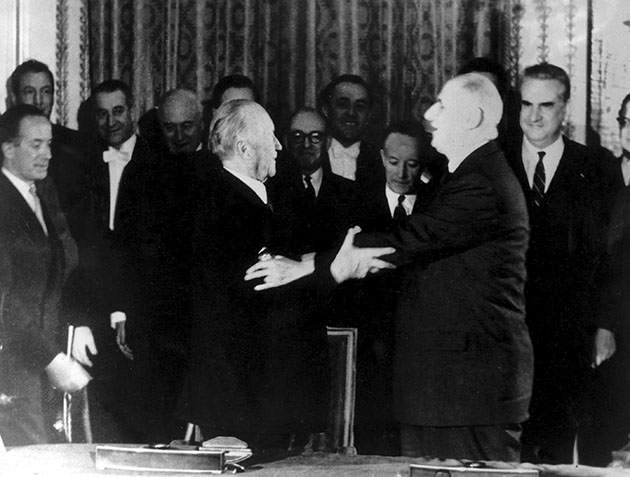
Konrad Adenauer and Charles de Gaulle after the signing of the Élysée Treaty, Paris, 22 January 1963. © Ullstein Bild / Roger-Viollet
The FGYO works with many institutional and voluntary-sector partners. Who are they and in what context do they interact with your organisation?
The FGYO operates on the principle of subsidiarity, with nearly 8 000 partner organisations. It delegates project implementation to these partners, which are schools, colleges, universities, charities and institutions. Its role is then to advise, support and fund the projects. By involving its partners in project implementation, the FGYO created a large network of Franco-German specialists, who contribute their expertise and work closely with young people. It plays the role of intermediary between local and regional authorities, and between civil-society organisations in France and Germany. Its wide variety of partners range from major national federations to small local organisations and schools.
Do French and German young people have the same relationship with remembrance?
It must be accepted that our relationship with remembrance is subject to social norms. Young people in France and Germany do not always have the same relationship with remembrance. But our two countries are similar in the way our societies view remembrance as a duty that allows no scope for refusal of remembrance or rejection of the past. One of the best illustrations of this is, in France, the expression devoir de mémoire (“duty of remembrance”), while in Germany there are texts that are considered “compulsory reading” (Pflichtlektüre). The FGYO approaches this duty from a multinational standpoint, so that young people compare their relationship with remembrance, learn the other’s viewpoint and draw lessons from this multiple perspective. Putting national groups from two or more countries into contact with each other has a definite impact on their perceptions and seems to greatly contribute to changing the historical and remembrance reading criteria.
What actions does the FGYO carry out to pass on the memory of contemporary conflicts to French and German young people? And how many young people are involved in those actions?
Remembrance work and peace education centre on the First and Second World Wars, issues around Holocaust remembrance, and other events and periods like colonialism and slavery. The FGYO’s main role is to advise and support partner organisations in implementing bi- or trinational projects. As part of those projects, youth organisations address history and memory as programme elements or as the main theme in a peace education perspective. Teacher training and conferences organised or funded by the FGYO ensure the quality of the projects is guaranteed.
In addition, the FGYO teams up with partner organisations to develop learning resources, which are made available free of charge to project organisers. It also supports bi- and trinational research groups and disseminates the results of their publications.
Finally, the FGYO organises or participates with its partners in major commemorative events, putting its expertise and networks at the service of Franco-German or international projects. With these projects, and with our exchange programmes, the FGYO supports on average 8 000 exchanges per year, involving around 190 000 young people.
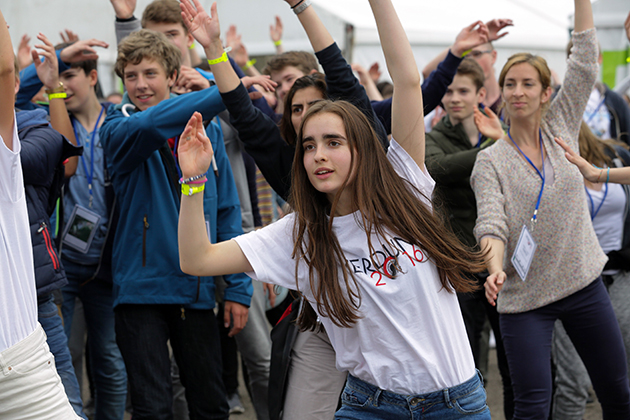
The “4 000 young people for Verdun” project, Verdun, 2016. © OFAJ
How are history and remembrance reflected in peace education?
To put the idea of peace education into practice as a way of educating for active democratic citizenship, the FGYO encourages its partners to address the themes of history and memory in the youth exchanges using a variety of methods and approaches. The accent is primarily on intercultural learning and a multi-perspective approach. Our differing points of view on history and remembrance are compared and contrasted, and can be explained by our culture and socialisation. A multiple perspective on history and memory leads not only to a better understanding of the other, a mutual discovery, but also to a questioning of the way we see things. An approach involving personal and family history makes young people aware that they are themselves a product of history and that they produce history through their own actions. This approach aims to interest young people in history by taking the discussion of their own history as a starting point.
The context of the place also plays a role, in an approach that takes in local, national and world history: the local history of the young people’s home town or of the place where the exchange takes place make them realise that there are traces of history all around us, whether in street names or commemorative plaques. The traces of local history reflect the “bigger history”, be it national or international, the two often being connected.
We have also noticed that an artistic approach enables young people to come to terms with their own history, their family history or a historical period. There are artworks that are also historical testimonies or testimonies of confrontation with history. The language of art has the capacity to put thoughts, impressions and emotions in dialogue with one another beyond the linguistic dimension.
Finally, through the discovery of monuments, memorials and museums, young people experience remembrance and peace education. The “4 000 young people for Verdun” project, part of the Franco-German commemorations to mark the centenary of the Battle of Verdun in 2016, is an example of our work on remembrance and peace education. As part of this Franco-German event, intercultural workshops were held with the goal of deconstructing prejudices and promoting mutual understanding, while at the same time passing on information about history and motivating young people to get involved in democracy and peace.
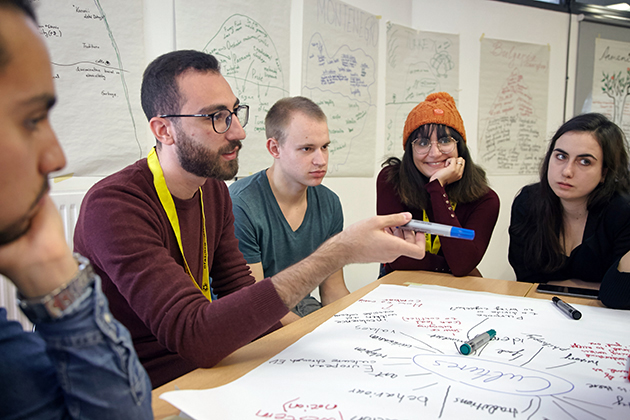
“Youth for Peace – Global tools, local action” youth conference, Paris, November 2019. © Julien Mazoyer
In this context, in 2018 the FGYO organised an international youth conference in Berlin on the theme “Youth for Peace: 100 Years after World War I, 100 Ideas for Peace”, with young people from 48 countries. This initiative was pursued on a reduced scale with the “Youth for Peace – Global tools, local action” project in Paris in 2019, and online since the start of the pandemic.
Your impact goes beyond the French and German borders. Can you tell us a bit more about it?
Since the 1970s, the FGYO has developed the concept of trinational projects and exchanges. By opening up to other EU countries, the FGYO was responding to the wishes of French president François Mitterrand and federal German chancellor Helmut Kohl, who wanted Franco-German cooperation to contribute to European unity. Since the fall of the Berlin Wall and German reunification, our organisation has stepped up its work with the countries of Eastern Europe, in particular Poland, in the tradition of the Weimar Triangle, and in the Mediterranean region, including North Africa.
At the turn of the century, for the first time ever the FGYO ran a project in a refugee camp in Kosovo and was given the task of intensifying its work in the Balkans, involving and training civil-society representatives from this region to organise youth exchanges in an intercultural perspective of cooperation.
With 15% of its operating budget set aside for trinational projects, the work with a third country took on increasing importance in the FGYO’s identity, not only as far as France and Germany were concerned, but also for European cooperation on an equal footing. The themes of reconciliation or conflict are not always addressed explicitly. By offering activities and subjects that unite young people, that knowledge is developed through the sharing of common interests and intercultural experiences. These conferences and exchanges enable young people to gain a better understanding of their own and others’ cultures, respect different viewpoints and discuss in a respectful and constructive way. The young people learn more about Franco-German friendship and cooperation, and often make the connection themselves with history and the relationship which their country has with others, and express the desire to contribute something comparable to the entente with their neighbour. The FGYO has also inspired the creation of many binational organisations in Europe, for example in Poland in 1991 with the German-Polish Youth Office, in 2016 with the Regional Youth Cooperation Office (RYCO), or more recently between Leipzig and Athens, with the German-Greek Youth Office.
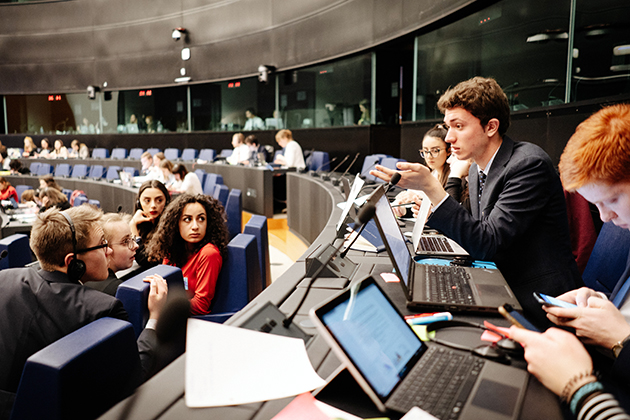
“Spread the vote”, conference and exchanges between 90 young people from France, Germany and Poland in the run-up to the EU elections,
16 April 2019, Strasbourg. © Antoine Guibert
At the beginning of the year, President Macron and President Steinmeier agreed to be the FGYO’s patrons. What message does that put across?
The signing of the Élysée Treaty on 22 January 1963 laid the foundations for Franco-German friendship and consolidated the role of France and Germany in European integration. Since that date, the FGYO has contributed to reinforcing those foundations by promoting the culture and language of the partner country among young people from France and Germany. As a protagonist of Franco-German dialogue, the FGYO mobilises young people for Franco-German friendship through its large network of partners and exchange programmes between the two countries. By becoming the FGYO’s patrons, 58 years after the signing of the Élysée Treaty, Emmanuel Macron and Frank-Walter Steinmeier encourage young people to get involved in consolidating Franco-German friendship. This distinction underscores the importance of carrying on with the youth exchanges to contribute to a peaceful future for Europe.
What are your main areas of development in the remembrance sphere for the next two or three years?
To capitalise on the rewarding experiences of recent years, we will be continuing our efforts to build a shared remembrance. Among our main areas of development are cooperation with the
Mémorial de la Shoah in Paris and the Haus der Wannseekonferenz in Berlin, a new partnership with the Erinnerung Verantwortung Zukunft (EVZ) foundation, and stepping up our work in the Balkans. Each young person has their own unique perspective on Europe. Only together can we confront the opportunities and risks of the 21st century. We need one another, and educating young people about peace and our common history has a decisive role to play, in the past and in the future, in the construction of a peaceful, unified Europe.
The editorial team
Educational guide “History and remembrance at the international youth exchanges”
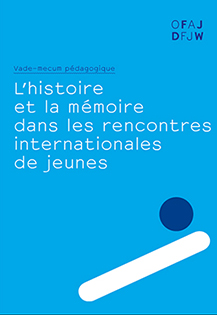
This guide presents the contexts in which history and remembrance may be addressed in the international youth exchanges. In particular, it suggests methods to enable young people to get to grips with their historical background, through a multi-perspective approach that has openness and dialogue at its centre.
The electronic version of the guide is available for download. The print version is available on request.
To find out more, visit the Franco-German Youth Office (FGYO) website (in French): https://www.ofaj.org/media/l-histoire-et-la-memoire-dans-les-rencontres-internationales-de-jeunes.pdf
From past to future, a century on: remembrance dynamics around the international exchanges and the “Great War”
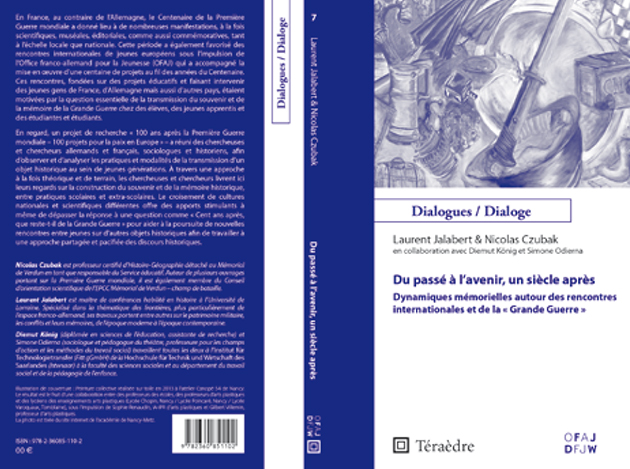
In France, unlike in Germany, the First World War centenary gave rise to a huge variety of academic, commemorative, editorial and museum events, both locally and nationally. It was also a busy time for European youth exchanges, driven by the Franco-German Youth Office (FGYO), which supported the implementation of around a hundred projects during the centenary period. These exchanges, based on educational projects and involving young people from France, Germany and other countries, were motivated by the fundamental question of passing on the memory of the “Great War” to school, college and university students.
One research project, titled “100 Years after the First World War – 100 Projects for Peace”, brought together French and German sociologists and historians to observe and analyse the practices and means of transmission of a historical subject to young people. Using a theoretical and fieldwork-based approach, the researchers presented, as Volume 7 of the Dialogues/dialogue collection, their perspectives on the construction of memory and historical remembrance across school and extra-curricular practices. The crossing of different national and scientific cultures provided stimulating contributions that went beyond answering a question like “100 years on, what remains of the ‘Great War’?”, to help pursue new exchanges between young people on other historical subjects and contribute to a shared, peaceful approach to historical narratives.
The authors
Laurent Jalabert is a lecturer in history at Lorraine University, specialising in the theme of borders, and more specifically the Franco-German area. His works are concerned with military heritage, conflicts and their memories, from the modern to the contemporary era.
Nicolas Czubak is a history and geography teacher, seconded to the Verdun Memorial as head of the education service. The author of several works on the First World War, he is also a member of the scientific advisory board of the Verdun Memorial and Battlefield.
Diemut König has a degree in educational sciences and is research assistant at the Institute for Technology Transfer (FITT gGmbH).Simone Odierna is a sociologist, theatre pedagogue and lecturer in social work methods and scope of action. Both work at the Faculty of Social Sciences and the Department of Social Work and Childhood Pedagogy at the Hochschule für Technik und Wirtschaft des Saarlandes (htw saar).
The book was also published by Waxmann in Germany, with the title: Dynamiken des Erinnerns in der internationalen Jugendarbeit - Geschichte, Gedenken und Pädagogik zum Ersten Weltkrieg

